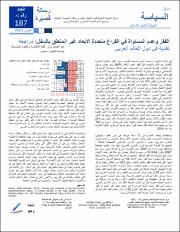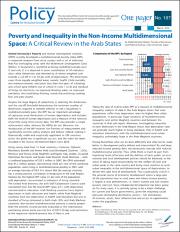Please use this identifier to cite or link to this item:
https://repositorio.ipea.gov.br/handle/11058/15008Files in This Item:
| File | Description | Size | Format | |
|---|---|---|---|---|
| ar_IPCOnePager187.pdf | 541.14 kB | Adobe PDF |  View/Open | |
| en_IPCOnePager187.pdf | 145.33 kB | Adobe PDF |  View/Open |
| Title: | Poverty and Inequality in the Non-Income Multidimensional Space: A Critical Review in the Arab States |
| Other Titles: | الفقر وعدم المساواة فى الفراغ متعددة الأبعاد غير المتعلق بالدخل: مراجعة نقدية فى دول العالم العربى |
| Authors: | Nawar, Abdel-Hameed |
| Abstract: | Oxford University’s Poverty and Human Development Initiative (OPHI) recently developed a multidimensional poverty index (MPI), a composite measure from micro surveys with a set of indicators that has overlapping areas with the Millennium Development Goals (MDGs). A household is identified as being multidimensionally poor if, and only if, it is deprived in some combination of 10 indicators (also called dimensions and denoted by d) whose weighted sum exceeds a cut-off k=3 or 30 per cent of deprivations. The dimensions cover three equally weighted areas, namely: health (child mortality and malnourishment), education (less than five years of schooling, and school-aged children out of school in years 1 to 8) and standard of living (no electricity, no improved drinking water, no improved sanitation, dirt/sand/dung flooring, wood/charcoal/dung cooking fuel, and poor assets). |
| metadata.dc.rights.holder: | International Policy Centre for Inclusive Growth United Nations Development Programme |
| metadata.dc.rights.license: | O texto e dados desta publicação podem ser reproduzidos desde que as fontes sejam citadas. Reproduções com fins comerciais são proibidas. |
| metadata.dc.type: | One Pager |
| Appears in Collections: | Publicações do IPC-IG |
Items in DSpace are protected by copyright, with all rights reserved, unless otherwise indicated.

